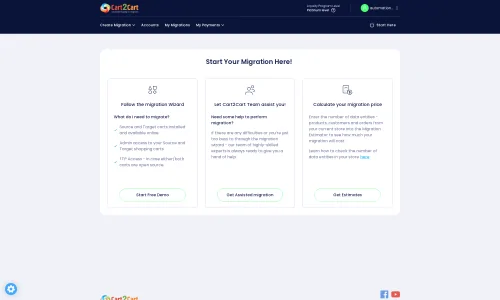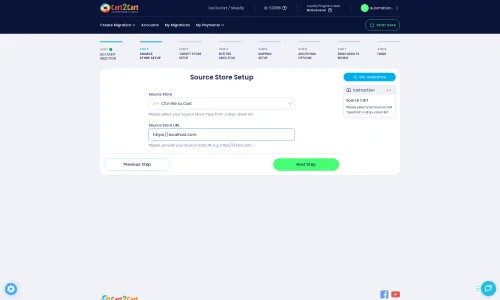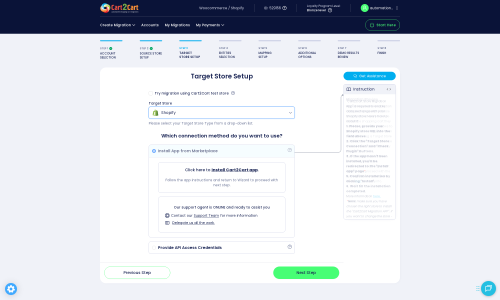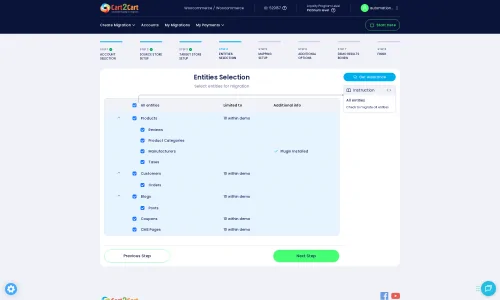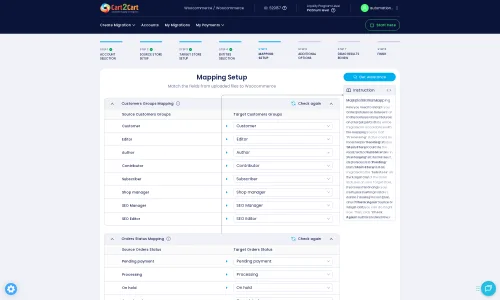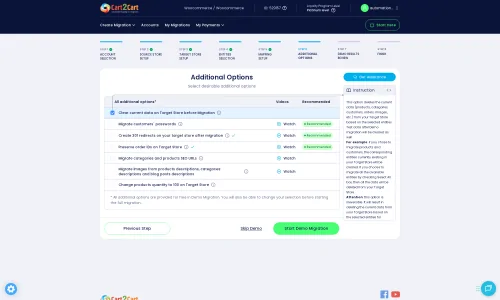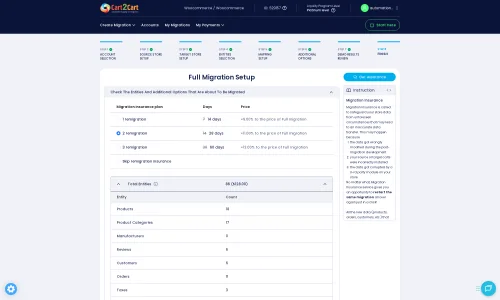StoreFront eCommerce to Shopify Migration - Step-by-Step Guide & Expert Services
StoreFront eCommerce to Shopify migration made simple. Ready to move StoreFront eCommerce store to Shopify for a powerful upgrade? Cart2Cart ensures a fast, secure switch from StoreFront eCommerce to Shopify with zero downtime. We expertly transfer data, preserving your SEO rankings and customer information effortlessly. Whether you prefer a detailed step-by-step guide for DIY or our expert assistance to get it done for you, achieve a seamless StoreFront eCommerce to Shopify migration with confidence. Your store's future is secure with us.
What data can be
migrated from StoreFront eCommerce to Shopify
-
Products
-
Product Categories
-
Manufacturers
-
Customers
-
Orders
Estimate your Migration Cost
Due to Cart2Cart`s flexible pricing policy, the migration price depends on the volume of transferred entities and the additional migration options you select. Just choose your Source and Target platforms and get the approximate price of your StoreFront eCommerce to Shopify store conversion right after completing the free Demo.
How to Migrate from StoreFront eCommerce to Shopify In 3 Steps?
Connect your Source & Target carts
Choose StoreFront eCommerce and Shopify from the drop-down lists & provide the stores’ URLs in the corresponding fields.
Select the data to migrate & extra options
Choose the data you want to migrate to Shopify and extra options to customise your StoreFront eCommerce to Shopify migration.
Launch your Demo/Full migration
Run a free Demo to see how the Cart2Cart service works, and when happy - launch Full migration.
Migrate from StoreFront eCommerce to Shopify: Your Definitive Guide
Seamlessly Migrating Your E-commerce Store from StoreFront eCommerce to Shopify
Embarking on an e-commerce platform migration can feel like a daunting task, but with the right strategy and tools, transitioning your online store from StoreFront eCommerce to Shopify can be a smooth and rewarding experience. This comprehensive guide is designed to provide you with clear, actionable steps for a successful data transfer, ensuring your valuable products, customer data, and order history make the journey intact.
Given that StoreFront eCommerce is not directly supported by automated connectors in the same way as other platforms, this migration will primarily leverage a CSV file export approach from your StoreFront eCommerce store, followed by an import into a robust migration tool. This method ensures maximum flexibility and data integrity as you move to the powerful Shopify ecosystem.
Shifting to Shopify can unlock a world of benefits, including a vast App Store, user-friendly admin interface, robust marketing tools, and a scalable infrastructure ready to grow with your business. Let's explore how to make this transition a success.
Prerequisites for a Smooth Migration
Before you begin the replatforming process, a little preparation goes a long way in ensuring data integrity and minimizing downtime. Here's what you'll need:
For Your Source Store (StoreFront eCommerce)
- Data Export: You will need to export all relevant data from your StoreFront eCommerce store into CSV (Comma Separated Values) files. This includes:
- Products (SKUs, variants, descriptions, images, pricing, inventory)
- Product Categories
- Customer Information (names, addresses, order history)
- Orders (details, statuses)
- Product Reviews
- CMS Pages and Blog Posts (if applicable)
- Data Audit: Review your current data for any inconsistencies or outdated information. Clean up your database to ensure only accurate data is transferred.
- Full Backup: Always perform a complete backup of your StoreFront eCommerce store's database and files before initiating any data export process. This is your safety net.
- For more detailed advice on preparing your source, refer to our guide on How to prepare Source store for migration?
For Your Target Store (Shopify)
- Shopify Account: Create a new Shopify account or ensure you have access to an existing one. Remember that a "Pause and Build" plan on Shopify will block orders, so consider your plan carefully during migration.
- Install Migration App: For a streamlined data transfer, you'll need to install a dedicated migration app. The Cart2Cart Store Migration App is required for connecting to Shopify. You will typically find this in the Shopify App Store.
- Disable Notifications: It is highly recommended to disable all store notifications (customer, order, shipping) within your Shopify admin during the migration process to avoid sending premature or incorrect alerts.
- Theme and Basic Setup: While data migration is underway, you can start exploring Shopify themes and essential configurations like payment gateways and shipping zones.
- Consult our How to prepare Target store for migration? FAQ for more insights.
Performing the Migration: A Step-by-Step Guide
This guide will walk you through the process using a migration wizard, with your StoreFront eCommerce data supplied via CSV files as the source.
Step 1: Set Up Your Migration Project
Start by registering an account with a reputable migration service that supports CSV imports and Shopify as a target platform. Once registered, you'll typically be guided to begin a new migration project.
Step 2: Connect Your Source Store (StoreFront eCommerce via CSV)
In the migration wizard, you will select your source platform.
- Choose "CSV File to Cart" from the dropdown menu as your source platform.
- You will then be prompted to upload the CSV files containing your StoreFront eCommerce data (products, customers, orders, etc.). Ensure your CSV files are formatted correctly according to the migration tool's guidelines. For assistance with this, you might consider a CSV.File Data Migration service.
Step 3: Connect Your Target Store (Shopify)
Next, you will configure your target store details.
- Select "Shopify" as your target e-commerce platform from the dropdown list.
- Provide your Shopify store's URL.
- The recommended connection method is to "Install App from Marketplace". Click the provided link to go to the Shopify App Store, install the Cart2Cart Store Migration App, and follow the on-screen instructions to establish the connection. Alternatively, some tools may offer an option to provide API access credentials directly, but the app method is generally simpler and more secure.
Step 4: Select Data Entities for Migration
This is where you specify exactly what data you want to move from your StoreFront eCommerce CSV files to Shopify.
- Review the list of available data entities, which typically includes: Products, Product Categories, Product Reviews, Customers, Orders, CMS Pages, and Blogs.
- You can choose to migrate all entities or selectively pick only the data types essential for your new Shopify store.
Step 5: Configure Data Mapping
Data mapping is a critical step to ensure that your StoreFront eCommerce data fields correctly correspond to Shopify's structure.
- You will need to map customer groups (e.g., "Wholesale" to "Customer" tags in Shopify) and order statuses (e.g., "Pending" to "Pending payment").
- Carefully review these mappings to maintain data consistency and integrity, especially for crucial customer and order information.
Step 6: Choose Additional Migration Options
Enhance your data transfer with various optional features that cater to specific business needs.
- Preserve Order IDs: This option allows you to maintain the original order numbers from your StoreFront eCommerce store in Shopify. Learn more about How Preserve IDs options can be used?
- Create 301 Redirects: Essential for SEO, this generates redirects from your old StoreFront eCommerce URLs to the new Shopify URLs, preserving your search engine rankings and link equity.
- Clear Current Data on Target Store: This option will remove any existing data in your Shopify store before the migration, ensuring a clean import. Read about Clear current data on Target store before migration option.
- Migrate Images in Product Descriptions: Ensures that all images embedded within your product and category descriptions are also moved.
- Migrate Customer Groups to Customer Tags: A useful option for organizing your customer base in Shopify.
Step 7: Perform Demo or Full Migration
- Run a Free Demo Migration: It's highly recommended to perform a demo migration first. This allows you to transfer a limited number of entities (e.g., 10 products, 10 customers, 10 orders) to your Shopify store, letting you verify the process and data accuracy without commitment.
- Initiate Full Data Transfer: Once satisfied with the demo results and all configurations, proceed with the full migration. This will move all your selected data from your StoreFront eCommerce CSV files to your new Shopify store. Consider opting for Migration Insurance Service, which provides multiple remigrations in case any issues arise. You can learn more about How Migration Insurance works?
Post-Migration Steps
The migration doesn't end when the data transfer is complete. A few crucial steps are needed to ensure your new Shopify store is fully operational and optimized.
- Thorough Data Verification: Rigorously check all migrated data on your Shopify store. This includes:
- Products: Ensure all SKUs, variants, prices, images, descriptions, and inventory levels are correct.
- Customers: Verify customer accounts, addresses, and order histories.
- Orders: Confirm order details and statuses. Pay attention to what will be the fulfilled date on Shopify target store?
- SEO URLs: Confirm that your 301 redirects are working as expected to preserve SEO rankings.
- Configure Shopify Storefront: Set up your Shopify theme, payment gateways, shipping methods, taxes, and any necessary third-party apps to enhance user experience and functionality.
- Update DNS Records: Point your domain name to your new Shopify store. This is the step that makes your new store live to the public.
- SEO Optimization: Submit your new Shopify sitemap to Google Search Console and monitor for any crawl errors. Verify that all essential metadata has been transferred correctly.
- Test Everything: Perform comprehensive testing of your entire store. Place test orders, check customer account functionalities, and ensure all links, images, and forms are working perfectly.
- Ongoing Monitoring: Keep an eye on your analytics and sales post-migration to quickly identify and resolve any unforeseen issues.
Migrating to Shopify is an exciting opportunity for growth and enhanced functionality. By following these steps and paying close attention to detail, you can ensure a successful transition, leveraging the potential benefits of a website migration for your business. For any further questions, consult our Frequently Asked Questions or Contact Us for expert assistance, including our Recent Data Migration Service for new orders or data updates post-migration.
Ways to perform migration from StoreFront eCommerce to Shopify
Automated migration
Just set up the migration and choose the entities to move – the service will do the rest.
Try It Free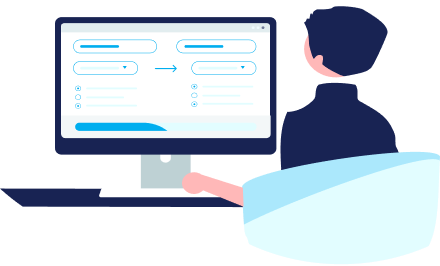
Data Migration Service Package
Delegate the job to the highly-skilled migration experts and get the job done.
Choose Package

Benefits for Store Owners

Benefits for Ecommerce Agencies
Choose all the extra migration options and get 40% off their total Price

The design and store functionality transfer is impossible due to StoreFront eCommerce to Shopify limitations. However, you can recreate it with the help of a 3rd-party developer.
Your data is safely locked with Cart2Cart
We built in many security measures so you can safely migrate from StoreFront eCommerce to Shopify. Check out our Security Policy
Server Security
All migrations are performed on a secure dedicated Hetzner server with restricted physical access.Application Security
HTTPS protocol and 128-bit SSL encryption are used to protect the data being exchanged.Network Security
The most up-to-date network architecture schema, firewall and access restrictions protect our system from electronic attacks.Data Access Control
Employee access to customer migration data is restricted, logged and audited.Frequently Asked Questions
What data entities can be migrated from StoreFront eCommerce to Shopify?
Will my StoreFront eCommerce store go offline during migration to Shopify?
How is my StoreFront eCommerce store data secured during the Shopify migration?
Should I use an automated tool or hire an expert for StoreFront eCommerce to Shopify migration?
What are the key cost factors for migrating my StoreFront eCommerce store to Shopify?
How can I preserve SEO rankings when migrating from StoreFront eCommerce to Shopify?
Can customer passwords be successfully migrated from StoreFront eCommerce to Shopify?
What is the typical timeline for a StoreFront eCommerce to Shopify migration?
How can I validate data accuracy after migrating from StoreFront eCommerce to Shopify?
Will my StoreFront eCommerce store's design and theme transfer directly to Shopify?
Why 150.000+ customers all over the globe have chosen Cart2Cart?
100% non-techie friendly
Cart2Cart is recommended by Shopify, WooCommerce, Wix, OpenCart, PrestaShop and other top ecommerce platforms.
Keep selling while migrating
The process of data transfer has no effect on the migrated store. At all.
24/7 live support
Get every bit of help right when you need it. Our live chat experts will eagerly guide you through the entire migration process.
Lightning fast migration
Just a few hours - and all your store data is moved to its new home.
Open to the customers’ needs
We’re ready to help import data from database dump, csv. file, a rare shopping cart etc.
Recommended by industry leaders
Cart2Cart is recommended by Shopify, WooCommerce, Wix, OpenCart, PrestaShop and other top ecommerce platforms.



